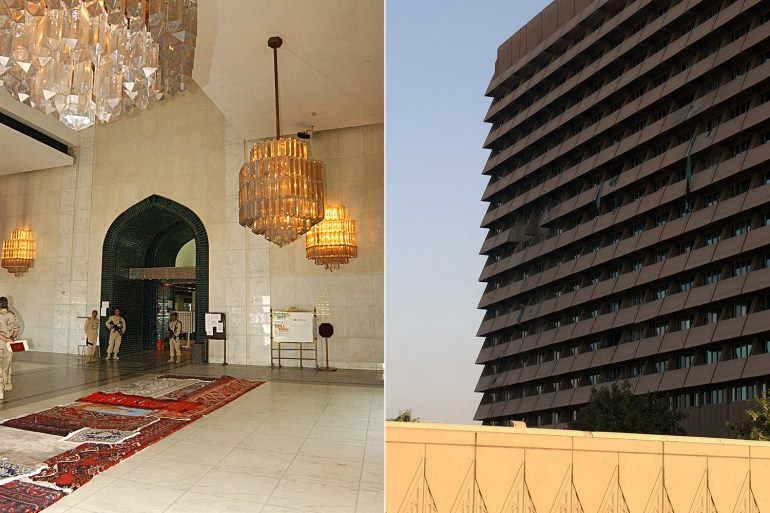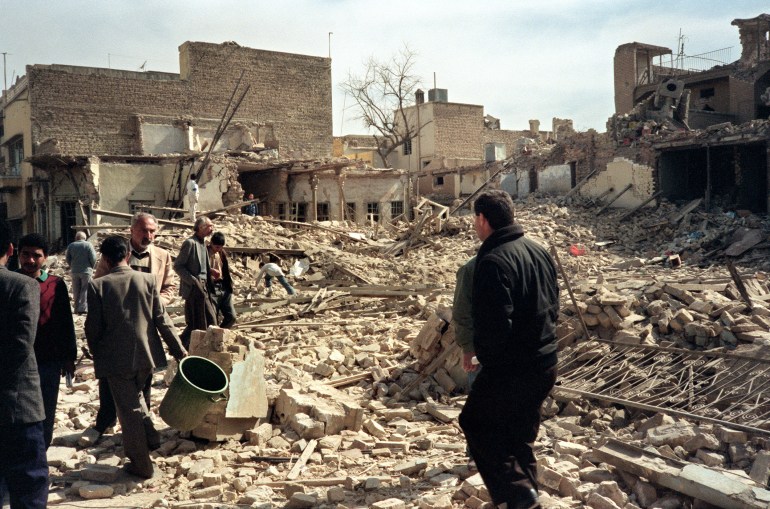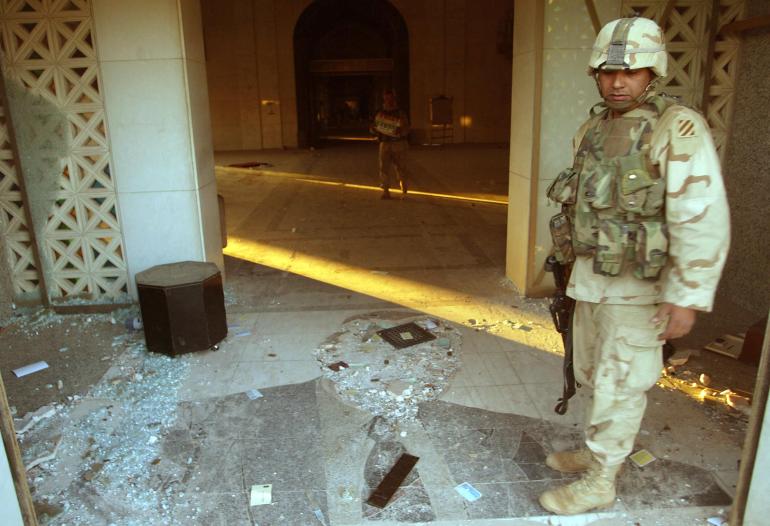Since its opening in 1982, the hotel has been central to the turbulent events experienced by the Iraqi capital.
When Baghdad’s five-star Al Rasheed Hotel opened four decades ago, it was billed as “more than a hotel”. The late-modernist building was intended, among other hotels, to host the 1983 Non-Aligned Movement summit, a gathering of countries that were aligned neither to the United States nor the Soviet Union during the Cold War. The hotel would never actually serve that purpose, but it nevertheless went on to become a place central to the turbulent events that the Iraqi capital experienced over the decades, not least as the place where foreign journalists reported from in 1991 during the first Gulf War.
Of all the hotels that filmmaker Abdallah El Binni and I researched for our book War Hotels (2022) and the Al Jazeera documentary series of the same name – which explored establishments such as the Caravelle in Saigon (today’s Ho Chi Minh City), Sarajevo’s Holiday Inn, and the Europa in Belfast – the Al Rasheed is perhaps the hotel that has had the most tumultuous history.
Located near the banks of the Tigris River, it was named after the 8th-century Caliph Harun Al-Rashid and would become a place where politics were almost part of the furniture. Guests entering or exiting the hotel were once obliged to insult former United States President George HW Bush by walking on a mosaic of his face on the floor of the lobby. The artwork, designed by the Iraqi artist Layla Al-Attar, was installed in 1991 after the end of the first Gulf War, largely destroyed by US troops in 2003 and completely removed in 2008. It depicted a snarling Bush and the message “BUSH IS CRIMINAL,” in English and Arabic. Treading on an individual’s face with the soles of one’s shoes is deemed highly offensive in Arab culture, but many guests did so willingly.
The mosaic reflected the fraught connection the Al Rasheed had with various American military interventions, from the first Gulf War (1990-1991) onwards. Over the years it became the lodging of choice for foreign media, businesspeople, and diplomats. It was damaged and partially ransacked during the US-led coalition forces’ invasion of Baghdad in 2003, and soon after became a base for the US military stationed in the country.

The place to be
When its doors opened, the Al Rasheed was considered the jewel among Baghdad’s newly built hotels. Construction was completed in 1982 and was funded with proceeds from Iraq’s tremendous oil wealth. Several other major hotels were built in Baghdad at the same time, including the Palestine Hotel, the Ishtar Sheraton Hotel and the Babylon Hotel, all cast as symbols of Iraq’s modernity and progress. The Al Rasheed was originally operated by the India-based Oberoi Group, though it was essentially nationalised and put under Iraqi government control five years later.
In its early years, the Al Rasheed was the place to go and was frequented by the upper echelons of the regime, the city’s elite and visiting foreign dignitaries. Eighteen floors high, it boasted a palatial interior, dark mahogany walls and doors, a marble lobby, a disco, fancy dining, coffee shops, the Scheherazade bar and a high standard of customer service. Outside, there were lush gardens, tennis courts and a swimming pool lined by palm trees.
The hotel was supposed to be one of the key venues for the seventh Non-Aligned Movement summit, scheduled to take place in March 1983. Hosting the event would not simply showcase the architectural achievements of Iraq’s then-ruler, Saddam Hussein. It would also demonstrate that, despite the war with neighbouring Iran, Baghdad was safe. Yet on July 21, 1982, an Iranian air force jet flew over Baghdad and attacked an oil refinery. It was then hit by an Iraqi surface-to-air missile as it approached the vicinity of the Al Rasheed. The attack dashed Iraq’s hopes of hosting the meeting, which was rescheduled and moved to New Delhi, India.

A darker side hidden in the walls
While the hotel nevertheless remained the most luxurious lodging in Baghdad, a darker side was hidden, quite literally, within its walls – in the form of a surveillance infrastructure that reflected, in microcosm, the totalitarian rule of Hussein. No one could evade the reach of his security apparatus, including hotel guests, who were subject to close scrutiny.
Almost all foreigners visiting the city would stay in the Al Rasheed, which, according to many of the journalists interviewed for the book War Hotels, was equipped with two-way mirrors, small spy cameras and listening devices concealed in their room’s television sets, not to mention the cameras in corridors and in the hotel’s public spaces. Staff from the management to the cleaners remained alert to the movements of guests, particularly journalists, who were conveying to the outside world what was happening inside Iraq, including the nature of Hussein’s regime.
“The Al Rasheed had many benefits. It had great views of the city, the food was good and the room service was excellent. We journalists were certainly listened to, but we got used to it. Indeed, in an environment such as Saddam Hussein’s Iraq, you always assumed pretty much everything we said was being recorded,” said Jeremy Bowen, the BBC’s international editor who spent lengthy periods in the hotel throughout the 1990s.
Despite being aware of the surveillance, journalists visiting Baghdad were obliged by authorities to stay in the Al Rasheed and be provided with “guides” from the Iraqi Ministry of Information, some of whom were also members of the country’s feared secret police, the Mukhabarat.

The four-wire system
The Al Rasheed would come to international prominence during the American bombing of Baghdad in January 1991, due largely to the reporting of a CNN team based in the hotel.
Until then, it was impossible to transmit live from the Iraqi capital. According to numerous foreign journalists who were based in Baghdad at the time, the only satellite uplink was in the Ministry of Information building, so all reports had to be filed, and footage transmitted, from there under the watchful eyes of minders.
The CNN crew established its own rudimentary broadcasting infrastructure using a “four-wire” system – a direct dedicated phone line that would prove vital for coverage after the war began. It was able to send live signals carried via underground cables from Baghdad to Amman, Jordan, from where it could be transmitted by satellite to CNN headquarters in Atlanta, the US.
“The key thing about the four-wire system we used in the Al Rasheed was that it went through a different telecommunications node, so in the first days of the war when the telephone lines and exchange were taken out, the four-wire continued to function,” said Nic Robertson, CNN’s international diplomatic editor, who had joined the company as a technician just before being posted to Baghdad after the Iraqi invasion of Kuwait in 1990. The invasion led to the US-led coalition embarking upon “Operation Desert Storm” which would not only drive the Iraqis out of Kuwait but hit targets within Iraq itself. No other news organisation in Baghdad had access to their system, which gave CNN an edge over competitors.
As Baghdad was bombarded from the air, CNN correspondents provided a live minute-by-minute, vivid account of the assault from their ninth-floor suite (Room 906) in the Al Rasheed, though they would later set up their operation in the Scheherazade bar.
Most of the other foreign crews were ordered to leave the city by the Iraqi government a few days later. CNN, which had forged relatively good relations with the Iraqi authorities, was one of the very few foreign media organisations permitted to remain, although their team, with the exception of Peter Arnett also departed, primarily for security reasons. Arnett, who was one of the few foreign journalists who had stayed in Saigon after it fell in April 1975, remained in Baghdad as the Al Rasheed emptied along with another foreign journalist, Alfonso Rojo from the Spanish newspaper El Mundo. Arnett said the Al Rasheed remained his “castle”. He was convinced the US military would not bomb it knowing that CNN was there.

‘Shuttered and grim’
After intense bombardment, foreign journalists were permitted to return to Baghdad in mid-February 1991 to find that conditions in the hotel had deteriorated. The bombing of the city had destroyed large parts of the city’s vital infrastructure meaning that the few guests in the hotel faced a lack of water, electricity and food.
Bowen returned to the Al Rasheed to find that much had changed. Having driven east across the desert from Amman with two colleagues, he found that many of the staff had departed and most services were now unavailable. It was, said Bowen, “Quite shuttered and grim. The electricity was out, so the whole hotel was in darkness, particularly the windowless corridors. They no longer provided food and the officials of the Iraqi regime that were there had changed out of their Italian suits and into green Ba’ath Party [which was led by Saddam Hussein] uniforms.”
Over the course of the decade, Iraq was subject to strict sanctions and the US military conducted a number of short bombing campaigns, many of which targeted Baghdad. The first, in January 1993, saw a projectile from a cruise missile that had broken up as a result of anti-aircraft fire, land between the hotel’s garden and the outdoor swimming pool. It killed a female receptionist and injured several other staff and guests.
The material damage was repaired, and the Al Rasheed again began to function near to capacity. The international media had largely moved elsewhere to cover conflicts in places such as Croatia, Bosnia and Herzegovina, Chechnya and Algeria, though small numbers kept a near-permanent presence unless they were ordered to leave by the Iraqi government.

A heavily fortified base
When, in March 2003, US President George W Bush ordered the invasion of Iraq, the Al Rasheed was more exposed, being located uncomfortably close to several key government buildings. Before the US-led coalition’s bombing of Baghdad began, foreign journalists scattered and left the Al Rasheed.
Abdallah El Binni, my War Hotels co-author, was in Baghdad in 2003 working for Abu Dhabi Television. “There was almost unanimity among journalists not to stay in the Al Rasheed hotel, which was near government buildings that we expected would be targeted,” he said. “The Palestine Hotel, located on the other side of the Tigris River, was the last resort, and we assumed not only that it would be the safest but that the American and coalition forces would not target a hotel packed to the brim with the international media.”

When US troops entered Baghdad in early April, with the city in chaos, looters stormed the Al Rasheed and stole a grand piano, furniture, refrigerators and air-conditioning units, among other things. In the meantime, the journalists based at the Palestine were not as safe as many had assumed. On April 8, the hotel was hit by an American tank shell, killing a Reuters cameraman Taras Protsyuk and José Couso of the Spanish network Telecinco.
Weeks later, the Al Rasheed had been taken over by the US military and repurposed as a heavily fortified base. Meanwhile, Iraqi militia resisting the US occupation now considered the hotel a highly prized target. On October 26, 2003, while the US Deputy Secretary of Defence, Paul Wolfowitz, was staying at the Al Rasheed, armed men fired rockets at the hotel from the back of a trailer pulled by a car. The blasts caused significant damage to the hotel’s façade, blowing out windows and killing a US soldier and injuring 17 people.
Then, after being used as a kind of military barracks, the US Army Corps of Engineers refurbished the hotel’s nearly 500 rooms during an extensive renovation process that was completed in 2008 so it could be returned to civilian use. During this renovation, the Bush mosaic, partly destroyed after 2003, was completely removed. Less than six months later, on August 19, 2009, a wave of car bombs detonated across the city causing renewed destruction, and the landmark building had to undergo significant renovation yet again.
The favoured perch
Since the 2009 attack, the Al Rasheed has experienced a lengthy period of stability, one that has allowed the hotel to re-establish itself as among the finest in Baghdad. Now part of the Netherlands-based Golden Tulip Hotels and several refurbishments later, the Al Rasheed has once again become a key destination for visitors to the city.
Located within Baghdad’s Green Zone, a fortified area that houses many Iraqi government buildings, the hotel offers something of an oasis of calm and luxury amidst the bustle of the city. It has restored its place as the favoured perch for visiting foreign diplomats, aid workers, journalists and businesspeople, though the history of the building, only 40 years old, can never be erased. The instability of the past, and the sense that such instability may visit again, quietly stalks the historic halls and corridors of this iconic hotel.
Source: Aljazeera
